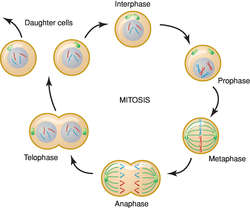Medical term:
mitotic
mi·tot·ic
(mī-tot'ik), Avoid the jargonistic use of this word as a synonym of neoplastic or malignant.mitotic
adjective Referring to mitosis.mi·tot·ic
(mī-tot'ik)mitosis
(mi-to'sis) (mi-to'sez?) plural.mitoses [Gr. mitos, thread + -osis]
Prophase: The chromatin granules of the nucleus stain more densely; the DNA strands coil extensively and become visible as chromosomes. These first appear as long filaments, each consisting of two identical chromatids, the result of DNA replication. Each pair of chromatids is joined at a region called the centromere, which may be central or toward one end. As prophase progresses, the chromosomes become shorter and more compact and stain densely. The nuclear membrane and the nucleoli disappear. At the same time, the centriole divides and the two daughter centrioles, each surrounded by a centrosphere, move to opposite poles of the cell. They are connected by fine protoplasmic fibrils, which form an achromatic spindle.
Metaphase: The chromosomes (paired chromatids) arrange themselves in an equatorial plane midway between the two centrioles.
Anaphase: The chromatids (now called daughter chromosomes) diverge and move toward their respective centrioles. The end of their migration marks the beginning of the next phase.
Telophase: The chromosomes at each pole of the spindle uncoil, the reverse of prophase, each becoming a long, loosely spiraled thread. The nuclear membrane re-forms and nucleoli reappear. Outlines of chromosomes disappear, and chromatin appears as granules scattered throughout the nucleus and connected by a lightly staining net. The cytoplasm divides (cytokinesis), resulting in two complete cells. This is accomplished in animal cells by constriction in the equatorial region; in plant cells, a cell plate develops in the same region and becomes the new cell wall. The period between two successive divisions is called interphase.
Mitosis is of particular significance in that genes are distributed equally to each daughter cell, and the diploid number of chromosomes is maintained in all somatic cells of an organism.
heterotypic mitosis
homeotypic mitosis
Latest Searches:
Wangiella - Wangensteen - wandering - Wambles - Walton - Walther - Walthard - Walt - Walsham - Wallstent - walleye - wallerian - Wallenberg - walking - Walker - WalkAide - walk - Waldeyer - Waldenstr?macroglobulinemias - Waldenstr?m -
- Service manuals - MBI Corp